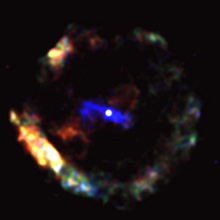January 10, 2001
CXC PR: 01-02
SAN DIEGO -- Scientists using NASA’s Chandra X-ray Observatory have found new evidence that a pulsar in the constellation of Sagittarius was created when a massive star exploded, witnessed by Chinese astronomers in the year 386 AD. If confirmed, this will be only the second pulsar to be clearly associated with a historic event.
These results were presented today by Victoria Kaspi and Mallory Roberts of McGill University at the American Astronomical Society meeting. Also participating in the research were Gautum Vasisht from the Jet Propulsion Laboratory, Eric Gotthelf from Columbia University, Michael Pivovaroff from Therma-Wave, Inc., and Nobuyuki Kawai from the Institute of Physical and Chemical Research, Japan.
The scientists used Chandra to locate the pulsar exactly at the geometric center of the supernova remnant known as G11.2-0.3. This location provides very strong evidence that the pulsar, a neutron star that is rotating 14 times a second, was formed in the supernova of 386 AD, and therefore has an age of 1615 years.
"Determining the true ages of astronomical objects is notoriously difficult, and for this reason, historical records of supernovas are of great importance,"said Kaspi."In roughly the past 2,000 years, fewer than 10 reports of probable supernovae have been archived mostly by Asian astronomers. Of those handful, the remnant of 1054 AD, the Crab Nebula, was until now the only pulsar whose birth could be associated with a historic event – and, hence, the only neutron star that has a firm age."
Between mid-April and mid-May in the year 386 AD, a young "guest star", presumably a supernova, was recorded by Chinese observers in the direction of the sky now known as the constellation of Sagittarius. In the 1970s, radio astronomers discovered an expanding nebula of gas and high-energy particles, called G11.2-0.3, that is believed to be the remnant of that explosion. In 1997, a team of X-ray astronomers used Japan’s ASCA satellite to discover a pulsar in the same area of the sky. Past attempts to identify the pulsar with G11.2-0.3, and hence the ancient Chinese observations, have been controversial.
The location of the pulsar at the center of the remnant provides new evidence that it is associated with the remnant. Since pulsars are known to move rapidly away from where they are formed, a pulsar near the center of the remnant implies the system must be very young, since not enough time has elapsed for the pulsar to travel far from its birthplace.
"We believe that the pulsar and the supernova remnant G11.2-0.3 are both likely to be left over from the explosion seen by the Chinese observers over 1600 years ago," said Roberts. "While this is exciting by itself, it also raises new questions about what we know about pulsars especially during their infancies."
These questions follow from a discrepancy that arose when the ASCA team applied the present spin rate to current models to determine the pulsar’s estimated lifetime and compare it to the age of G11.2-0.3. The result was an age of roughly 24,000 years – far predating the birth year of 386 AD.
To explain this contradiction, the Chandra team argues that this pulsar may have had approximately the same spin rate today as it did at its birth, as had been suggested by the ASCA data. If this is true, then it could have important implications for the conventional wisdom regarding pulsars, which, may be born spinning more slowly than has been thought.
"We now have strong evidence that the standard age estimate for this pulsar is probably wrong, and it is much younger than previously believed," said Kaspi. "This, in turn, suggests that other standard pulsar age estimates may be wrong as well, and this has important implications for the population as a whole."
In addition to these results, the Chandra observations of G11.2-0.3 have, for the first time, revealed the bizarre appearance of the pulsar wind nebula (also known as "plerions") at the center of the supernova remnant. Its rough cigar-like shape is in contrast to the graceful arcs observed around the Crab and Vela pulsars. However, together with those pulsars, G11.2-0.3 demonstrates that such complicated structures are ubiquitous around young pulsars. This has left astronomers confounded.
Chandra observed G11.2-0.3 with the Advanced CCD Imaging Spectrometer at two epochs: August 6, 2000, and October 15, 2000, for approximately 20,000 and 15,000 seconds respectively.
The ACIS X-ray camera was developed for NASA by Pennsylvania State University and MIT. NASA's Marshall Space Flight Center in Huntsville, AL, manages the Chandra program. TRW, Inc., Redondo Beach, California, is the prime contractor for the spacecraft. The Smithsonian's Chandra X-ray Center controls science and flight operations from Cambridge, MA.
In addition to their appointments at McGill, Dr. Kaspi is also affiliated with the Massachusetts Institute of Technology and Dr. Roberts is a Quebec Merit Postdoctoral Fellow. Funding for this work was provided by NASA, NSF, and NSERC (Canada).
During the AAS meeting, the scientists involved in this release can be reached at the AAS Press Room at the Town & Country Resort in San Diego, CA. The phone numbers for the Press Room are (619) 908-5057, (619) 908-5040, and (619) 908-5041 from January 8-11.
Images associated with this release are available on the World Wide Web at:
MEDIA CONTACTS
Dolores Beasley
NASA HQ
Phone: 202-358-1753
Steve Roy
Marshall Space Flight Center, Huntsville, AL
Phone: 256-544-6535
Megan Watzke
Chandra X-ray Observatory Center, CfA, Cambridge, MA
Phone: 617-496-7998



